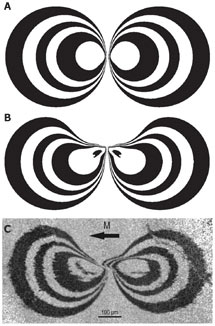
Handy Links
SLAC News Center
SLAC Today
- Subscribe
- Archives: Feb 2006-May 20, 2011
- Archives: May 23, 2011 and later
- Submit Feedback or Story Ideas
- About SLAC Today
SLAC News
Lab News
- Interactions
- Lightsources.org
- ILC NewsLine
- Int'l Science Grid This Week
- Fermilab Today
- Berkeley Lab News
- @brookhaven TODAY
- DOE Pulse
- CERN Courier
- DESY inForm
- US / LHC
SLAC Links
- Emergency
- Safety
- Policy Repository
- Site Entry Form

- Site Maps
- M & O Review
- Computing Status & Calendar
- SLAC Colloquium
- SLACspeak
- SLACspace
- SLAC Logo
- Café Menu
- Flea Market
- Web E-mail
- Marguerite Shuttle
- Discount Commuter Passes
-
Award Reporting Form
- SPIRES
- SciDoc
- Activity Groups
- Library
Stanford
Around the Bay
Electric Sensation at the Final Focus Test Beam
The figure-eight pattern is a magnetic contrast image. After the electron beam passes through the magnetic film, the researchers take it out of the accelerator and look at it with a SEMPA microscope—a Scanning Electron Microscope with Polarization Analysis. This microscope can "see" the magnetic orientation of electrons in the film: either to the left (white), or to the right (black). (Image courtesy of the research team.)
Five SLAC scientists and their collaborators have started a new chapter in the field of electromagnetism with research that could change the way your computer stores data. Their results, which appear on the front cover of the May 29 issue of Physical Review Letters, demonstrate for the first time a way to change a magnet's polarity using an electric rather than magnetic field.
Most computer hard drives store data using magnetic fields generated by small coils. The current flowing through the coil generates a magnetic field that flips the orientation of a series of magnets back and forth. These coils are generally bulky and the current produces a lot of heat, so scientists have theorized that your computer could apply an electric field to write data instead.
"You would have the potential for a mechanism which can switch magnets a lot faster and with a lot less heat loss," explained Sara Gamble, a Stanford graduate student and co-author on the paper. But scientists have been unable to make an electric field affect a magnet's polarity the way a magnetic field does. Now, Gamble and her fellow researchers have changed that, and opened the door for a new technology.
Gamble, along with fellow graduate student Mark Burkhardt, SLAC scientists H. C. Siegmann and Jo Stohr, and outside collaborators Alexander Kashuba, Rolf Allenspach and Stuart Parkin, all specialize in magnetism. The group had set out to use the SLAC linear accelerator's Final Focus Test Beam to study the effects generated by electron pulses of different lengths on magnetic films of metal. In the FFTB, the team worked with electron beam pulses, in which the electrons are grouped into bunches. Each bunch generates magnetic and electric fields as it passes through the metal. The magnetic field changes as it moves outward from the beam, affecting different portions of the metal film differently. As a result, the magnetization of the metal oscillates back and forth in figure-eight-like rings around the beam. But as the team applied the shorter and faster of the two beams, the resulting rings appeared warped. Something other than the beam's magnetic field was affecting the metal's magnetization.
As it turns out, the ultrafast electron bunches from the SLAC linac provided unique circumstances that set the stage for the team's discovery. First, the electric fields of the shorter electron bunches are strong enough to rival the bonds that hold the metal's atoms together. The pulses are short enough, however, to avoid breaking the atoms apart. Secondly, the electric field created by the electron bunches is spherical at rest, but when flying down the linear accelerator at nearly the speed of light, it flattens out like a pancake. Normally, the laws of physics will cause a conductor, like a sheet of metal, to block an electric field from entering into it . But the pancake-like shape of the electric field, which lies parallel to the magnetic film, allows it to penetrate into the metal. The warped circles that the team saw were the result of the electric field flipping the magnetization direction of the metal, just the way the magnetic field could. In technical terms, the team had observed the first electric-field induced magnetic switching, and had shown that this could be done more than 1000-times faster than present-day data storage.
To produce this effect with electrons requires a beam like the one at the SLAC linear accelerator, but the researchers said it would be possible to create a tabletop version using laser light. "You can get fields this strong with laser pulses, so there's a possibility of being able to use the field of a photon pulse to do this," Gamble said. "One day there could potentially be a table-top version of our experiment. We haven't done that, but you can see from the physics that it is feasible."
—Calla Cofield
SLAC Today, June 11, 2009
